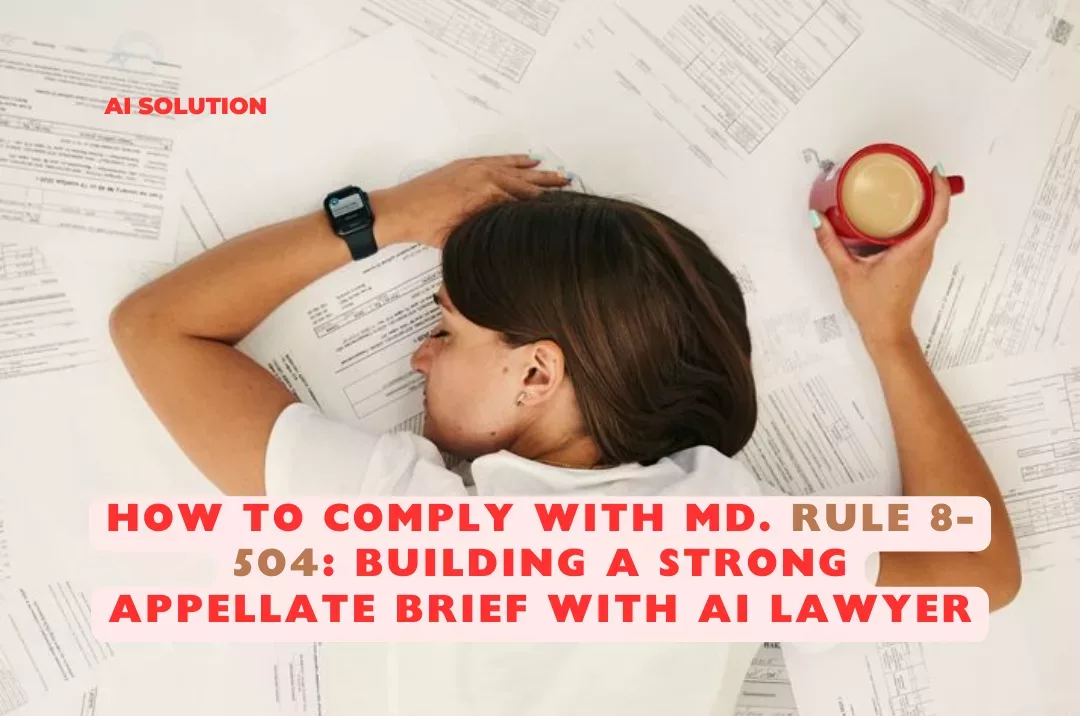Md. Rule 8-504
Rule 8-504 — Contents of Brief
(a) Contents

(1) Generally
A brief shall meet the requirements of Rule 8-112, and contain, in the order set forth, the following items:
• (A) A table of contents
• Purpose: To provide the court and opposing parties with a road map of the structure of the brief.
• Practical Tip: Page numbers should not have any missing to avoid confusion.
• (B) A statement of the case
• Content: A concise summary of the proceedings in the lower court(s) and the nature of the judgment or order being appealed.
• Practical Tip: This is not the place to argue the merits; focus on the procedural posture and factual background.
• (C) A statement of the questions presented
• Purpose: To clearly identify the legal or factual issues the appellate court is being asked to decide.
• Practical Tip: The clearer and more precise the questions, the easier it is for the court to understand the scope of your appeal.
• (D) A statement of facts
• Content: A narrative of the relevant facts of the case, with specific citations to the record (transcript or record extract, if applicable).
• Practical Tip: Provide pinpoint citations to assist the court in verifying the facts quickly.
• (E) Argument
• Purpose: The primary section for legal analysis, presenting the party’s reasoning supported by statutes, case law, and other authorities.
• Practical Tip: Align each argument with a corresponding question from the “Questions Presented” section; use subheadings for clarity.
• (F) So what?
• Content: A concise statement of the relief sought (e.g., reversal, affirmance, or modification of the lower court’s ruling).
• Practical Tip: Use precise language such as “Appellant respectfully requests that this Court reverse the judgment below” to be unambiguous.
• (G) In cases involving the constitutionality, construction, or application of a statute, rule, or ordinance…
• Content: Include or quote pertinent provisions if they have not been fully set out in another portion of the brief.
• Practical Tip: If these provisions are already included in an opposing party’s brief, cross-reference them rather than duplicating the entire text.
(2) Additional Required Items

Any other matter required by rule or order of the Court of Appeals or the Appellate Court shall be included under appropriate headings.
(3) Compliance with Form Requirements
A brief shall be double-spaced or otherwise conform to the formatting standards in Rule 8-112. Any page or word-count limits must be strictly followed.
Comment: Some circuit courts or administrative orders may impose additional local rules regarding format, filing deadlines, or electronic submission requirements.
(b) Cross References
• Rule 1-104 (Unreported Opinions) — Governs citation and precedential status of unreported opinions in Maryland.
• Rule 8-112 (Form and Style of Briefs and Other Papers) — Sets forth technical requirements (font, line spacing, numbering) for all appellate documents.
• Rule 8-503 (Filing and Service of Briefs) — Explains filing deadlines, service methods, and other procedural steps for briefs.
(c) Consequences of Non-Compliance
If a brief does not substantially comply with this Rule, the Court may, on motion or on its own initiative, require conformance with the Rule, strike the brief, dismiss the appeal, or take any other action it deems appropriate.
Example: If the table of contents is incomplete or the argument fails to follow the organizational structure mandated by the Rule, the Court can order the party to correct the brief. In more severe cases (particularly if the non-compliance appears deliberate), the Court may dismiss the appeal.
Historical Notes
1. Source
Section (a) is derived from former Rules 1031 (governing appeals to the Appellate Court) and 831 (governing appeals to the Court of Appeals). Sections (b) and (c) incorporate subsequent revisions aimed at streamlining the appellate process.
2. Amendments
• Adopted November 19, 1987, effective July 1, 1988.
• Renumbered November 12, 2003, effective January 1, 2004.
• Amended May 8, 2007, effective July 1, 2007.
• Amended April 21, 2023, effective July 1, 2023.
3. Committee Note
Briefs should be prepared in a manner that facilitates the Court’s review. Accurate pinpoint citations to the record extract or transcript are strongly encouraged to expedite the fact-checking process.
Commentary
Purpose of the Rule:
Rule 8-504 ensures every brief in Maryland’s appellate courts follows a standardized structure, making it easier for judges and parties to locate key legal arguments, procedural history, and supporting authorities.
Practical Implications:
• Efficiency: Adhering to the required format reduces delays caused by motions to strike or to supplement the record.
• Professionalism: A properly organized and fully compliant brief signals to the Court that counsel (or the party) is diligent and respectful of judicial resources.
Interaction with Other Rules:
• Rule 8-112 addresses the stylistic and technical format (e.g., spacing, fonts, margins), complementing the substantive requirements of Rule 8-504.
• Rule 1-104 is essential for determining whether and how unreported opinions can be cited in Maryland.
Need Help Preparing or Reviewing Appellate Briefs?
If you have any questions about Md. Rule 8-504 or require assistance drafting a brief that meets all the technical and substantive requirements, AI Lawyer is here to help. Our platform combines legal expertise with advanced technology to streamline document preparation and ensure compliance with Maryland’s appellate rules.
Ready to Elevate Your Appellate Advocacy?
• Contact us at AI Lawyer to discuss how we can assist you.
• Expert Guidance: Our team stays up to date on the latest amendments, so you don’t have to.
• Efficient Solutions: We offer step-by-step support to help you file properly formatted and thoroughly researched briefs.
